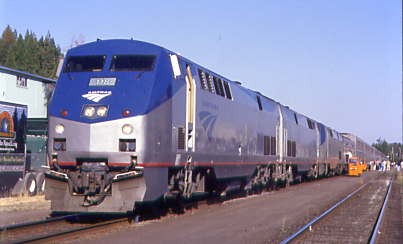
Sometimes in my life, I have no plans. I just had planned to stay home the rest of the summer and rest for work since the new school year started in September. That changed one Sunday morning in mid-August when I received a certain e-mail, asking me to cover the Trains Unlimited Tours' Domes to the Feather River Railroad Days for Trainweb.com. I set up to ride Amtrak's San Joaquin service to Oakland and back from Sacramento which was going to be a nice weekend trip. Next, a phone call two days later from Steve Grande, owner of Trainweb.com, had me going to Seattle to cover the relaunching of the Empire Builder and riding to Whitefish. That would get me back to Oakland with an extra day so I could ride all of Bay Area Rapid Transit, as well as Caltrain's Baby Bullet.
Fred Dunn, another Trainweb.com writer, would be travelling with me as far as Portland so he could cover the relaunching of the Empire Builder from Portland to Chicago. I purchased my tickets on Thursday and packed Friday morning before being taken to the Santa Ana station. Let the trip begin!
Pacific Surfliner 763 8/19/2005Standing on the platform having nice pleasant conversations with some of my future passengers is always an excellent way to start a trip. I spoke with Gary, our outstanding Amtrak agent here at Santa Ana, as Pacific Surfliner 763 arrived with cab car 6905, coaches 6408, 6412 and 6414, café/coach 6303, Pacific Business Class 6803 and F59PHI 454 pushing. We passed the low-level Pacific Surfliner 564 at Orange before stopping at Anaheim and Fullerton, where Fred Dunn joined me then arrived at Los Angeles Union Station on time and would sit on the first class benches on the platform to wait for the Coast Starlight.
Coast Starlight 14 8/19/2005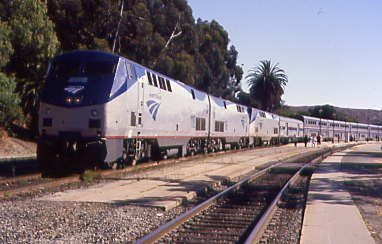
It was well past the departure time before the Coast Starlight reversed in at 10:45 AM. The power for our train was P42DCs 118, 116 and 57 with baggage 1248, transition 39021, sleepers 32019 "South Dakota", 32072 "Arkansas" and 32093 "Missouri", Pacific Parlour Car 39974, diner 38040, lounge 33048, coaches 34061, 34515 Kiddie Car, 34034 and 31009. Fred and I visited the Pacific Parlour Car and I enjoyied a pair of cinnamon rolls prior to returning to our room and we departed LAUPT at 11:16 AM {10:15 AM}.
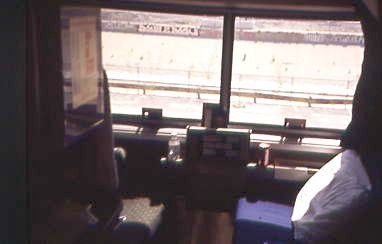
Our room, Deluxe Room B, in the "South Dakota", in which Brandy was our sleeping car attendant, as we rolled along the Los Angeles River. We reached Van Nuys after some stop-and-go running, departing at 11:51 AM {10:42 AM}, then west of there, we waited for Pacific Surfliner 774 to pass on its way to San Diego and continued to Simi Valley, departing at 12:25 PM {11:23 AM} then onward to Oxnard, from which we left at 1:02 PM {11:55 AM}. Our coastal running started on a beautiful clear day after Ventura and lasted through to Santa Barbara, a fresh air stop, which we departed at 1:55 PM {12:48 PM}.
Since Ventura, I was sitting in those big comfortable chairs that I enjoy so much in the Pacific Parlour Car. Dolphins were spotted playing before Gaviota and on a day this clear, I truly loved the views of Point Conception, Jalama Beach and Point Arguello before we crossed Vandenberg Air Force Base. We took the siding at Tangair for Pacific Surfliner 799 which was an all-Surfliner consist. The jointed rail before Guadalupe certainly brought back some rail-riding memories. Good conversation with a fantastic lady from New York made the time go by quickly to our next fresh air stop of San Luis Obispo.
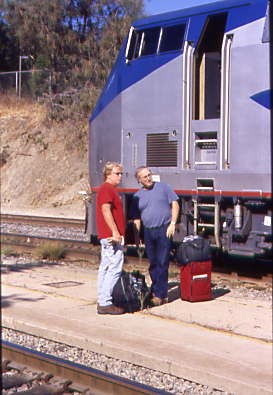
The engine crews changed at San Luis Obispo.
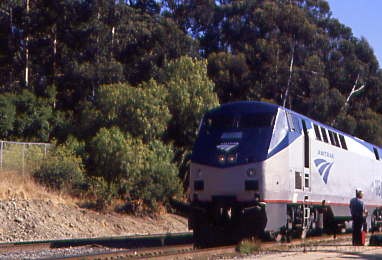
A different view. We departed at 5:02 PM {3:43 PM} before starting to climb Cuesta Grade.


Climbing the Goldtree Horseshoe Curve. Fred and I went to the dining car at 5:30 PM for dinner off Menu 2. Our waiter was the always-fantastic Ricky Williams and I had the New York strip with a chocolate sundae and Fred enjoyed his catfish and key lime pie then returned to the Parlour Car for more good conversations as the train travelled down the Salinas Valley. At King City, we met the southbound Coast Starlight, running just over seven hours late and we followed Union Pacific 4250 west to Soledad, whose conductor jumped off and threw the switch to keep us on the mainline; we picked him up and took him to his train's front end. That train had Union Pacific 4250 and CSX 7861. After the fresh air stop at Salinas, I asked Brandy to make up the room for the night and watched so I would know what to do in the future. I next went to the Parlour Car theater and watched most of "Sahara" then took the upper bunk after losing the lower bunk to a coin flip with Fred and called it a night.
8/20/2005 During the night, we departed Sacramento at 2:50 AM {11:59 PM} and I was up as we left Redding at 6:17 AM {3:14 AM}. I went to the Parlour Car just as the train was about to cross the Redding Trestle then at 6:35 AM, the dining car opened and I enjoyed my usual breakfast of French Toast and sausage. stopping at Central Valley to meet the southbound Coast Starlight running four-and-a-half hours late. The sun rose after we started to move, so it would be yet another daylight trip up the Sacramento River canyon. I noticed we now had dome car "Sierra Hotel" on the rear.
Later at Conant, we went into the siding for Union Pacific 4984 West followed by the EC4 rail detector car. I pointed out Castle Crags and Mount Shasta for the Parlour Car passengers and we departed Dunsmuir at 8:59 PM {5:04 AM} as I showed Shasta Springs and the Cantara Loop. At Mott, Union Pacific 6403 West was holding the mainline and passengers were busy taking pictures of Mount Shasta. After Black Butte, I was not feeling that well and returned to the room for some rest but later before Klamath Falls, I walked to the rear coach.
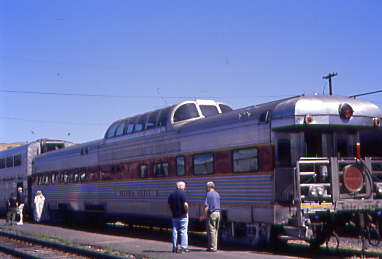
Chicago, Burlington and Quincy dorm-buffet-lounge 251 "Sierra Hotel" 1991 PPCX 800275 ex. "Golden Arrow" (lease), exx. Midwest Railcar open-end observation car, exxx. Vandalia Railroad/Charles Barenfanger/Doug Ebert 1987, exxxx. Amtrak 9811 1971, exxxxx. Burlington Northern 803 (not applied), exxxxxx. Burlington Northern 251, nee Chicago, Burlington and Quincy 251 "Silver Lounge" built by Budd Company in 1948 for use on the "California Zephyr" as a dome- dormitory-coffee shop car that provided overnight accomodations for the train's staff.
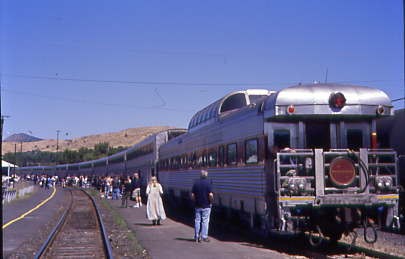
The rear of the Coast Starlight at Klamath Falls, Oregon, from which we departed at 12:33 PM {8:26 AM} and proceeded north.
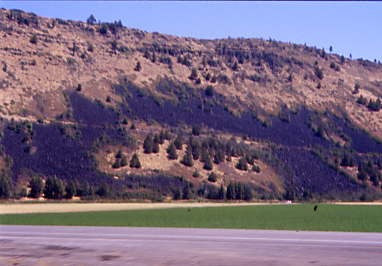
Running along Upper Klamath Lake, I could not pass up this scene. Fred and I talked for the next hour as we continued to Chemult, departing there at 2:04 PM {9:40 AM} and we enjoyed the crossing of the Cascade Summit from our Deluxe Room.
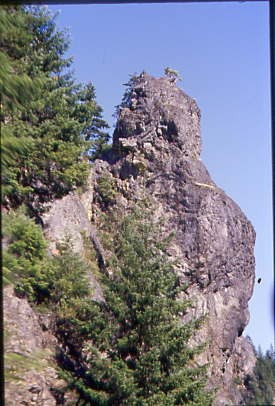
Rooster Rock before Oakridge, after which I went to see the first few minutes of "Sahara" that I had misssed last night while Fred enjoyed the wine tasting in the Pacific Parlour Car. I observed Lookout Point Reservoir down about twelve feet from the previous time I passed it last month.

The Coast Starlight at Eugene on a hot afternoon.
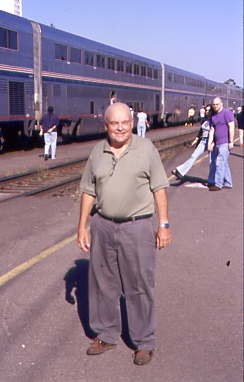
Fred during the fresh air break. We departed at 5:24 PM {12:44 PM} and proceeded north then at Shedd, Union Pacific 5831 East was in that siding as we went flying by. At Hallawell, we met the southbound Coast Starlight in that siding, already running an hour-and-a-half late. Albany was departed from at 6:14 PM {1:30 PM} and Union Pacific 3123 West delayed us at Millersburg. I had another steak for dinner but still did not feel like my old self. At Renard, we waited for Amtrak Cascades 507 to enter the siding behind a freight so we could run to Salem, from which we departed at 7:04 PM {2:03 PM}. We made our way to Portland Union Station, arriving there at 8:16 PM and I said goodbye to Fred, whom I knew was glad to be detraining at a decent hour. I, however, still had four more hours to go to Seattle. We left "Sierra Hotel" here and departed at 8:53 PM {4:05 PM}, as I napped by putting down the lower bunk and using the chair to make it like my usual roomette.
8/21/2005 I slept to within twenty minutes of Seattle and woke up my old self; a little sleep always does wonders for me! The Coast Starlight arrived in Seattle at 12:44 AM {8:30 PM}, ending a very interesting trip.
Seattle 8/21/2005I took the first taxi to the Kings Inn for the rest of the night then visited MacDonald's for breakfast and Ralph's for some goodies.
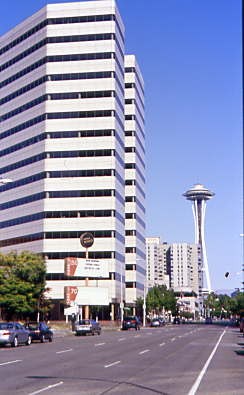
The Space Needle later that morning. I called Amtrak to purchase a coach round-trip to Havre as there is not much to do in Whitefish all day and would also give me another opportunity to ride over Marias Pass. Who would not want to do that? I watched program on TV Land before checking out then walked down to the Waterfront Streetcar.
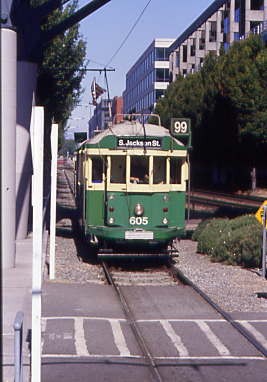
Waiting for this former Melbourne Australia Waterfront Streetcar 605 to take me to King Street Station.
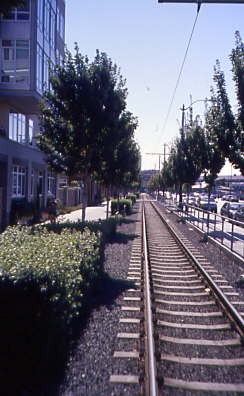
A view down the tracks along the Seattle Waterfront.
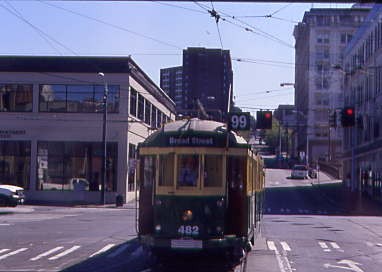
Car 482 going onto the passing track. At King Street Station, I paid for my new tickets and stored my luggage in the baggage room for the early afternoon.
King Street Station Restoration Progress 8/21/2005The station at Seattle has been in a state of restoration for the last year. These pictures will give you an idea of what the final station will be returned to.
Seattle's King Street Station was built between 1904 and 1906 adjacent to reclaimed tideland south of the city's downtown. The imposing concrete, granite and brick structure was financed by James J. Hill (1838-1916), who controlled both the Great Northern Railway that approached the city from the north and the Northern Pacific Railway Company that approached from the south. The station, located at the foot of King Street and bordered on the east by South Jackson Street, was the city's first elegant passenger depot and replaced an inadequate wooden structure built on Railroad Avenue after the Great Seattle Fire of 1889.
The exterior design of the King Street Station was a mash-up of styles known in the vernacular as "Railroad Italianate". City historic-preservation documents describe it more particularly as "Beaux Arts -- Neoclassical, Commercial, Italian -- Italian Renaissance" and note that "the campanile, with its prominent clock, is the building's most distinguishing feature and is based on the campanile on the Piazza San Marco in Venice".
The steel-framed building was L-shaped, the long side measuring 230 feet and the short leg 135 feet. The square, 242-foot clock tower, which until the Smith Tower was completed in 1914 was the tallest structure in Seattle, sat in the notch at the intersection of the building's two legs and featured a 14-foot-wide clock dial on each of its four faces, the mechanisms built and installed by E. Howard & Company of Boston. The ground floor was reinforced concrete with granite facing on the exterior and the upper two floors were solid brick masonry faced with pressed brick. A thick terra cotta entablature ringed the building where the walls met the roof, and additional terra cotta detailing framed the windows. Other decorative elements were of both terra cotta and cast stone. All was topped by a tile-covered hipped roof, and at the building's rear long shed roofs gave shelter to those getting on and off the trains.
When passengers entered the interior of the station they were surrounded by elegance, later described by the Seattle Department of Transportation: "When the station was opened to the public in May 1906, its grand waiting room had ornamental plaster ceilings. The plaster walls were interspersed with fluted Corinthian columns. The lower part of the walls and columns had white marble accented with glass mosaic tiles in white, green, red and gold. A massive bronze chandelier hung in the center of the main waiting room. Along with four smaller chandeliers and wall sconces, they provided illumination for the passengers inside the station. The terrazzo floor had inlaid square mosaic tiles. This created a compass shaped pattern at the station entrance and other rectangular patterns throughout the rest of the areas" (King Street Station Renovation).
During the first half of the twentieth century, as air travel became more common and the fortunes of passenger trains went into decline, many of the classic old railroad depots around the country fell into disrepair. The King Street Station was no exception. At some indeterminate time. the hands on its four large clocks stopped moving and for years were right only twice a day. The interior grew shabby, repairs went undone, maintenance was minimal. The once-grand depot began to resemble an aging bus terminal, and during the long decades of railroad consolidation and retrenchment nobody seemed to care.
It was not the passage of time alone that robbed the King Street Station of its original beauty. During the mid-twentieth century ,a series of ill-conceived renovations removed or concealed much of its once-elegant interior. The Seattle Department of Transportation provides a succinct description: "A series of renovations in the 1940s, 50s and 60s ... removed the plaster and marble walls, glass mosaic tiles and covered the plaster ceiling with acoustical tiles. The historic light fixtures were replaced with fluorescent lights. The terrazzo floor was cracked and in disrepair" (King Street Station Renovation).
And worse. Windows were boarded up, wood-and-glass doors replaced with metal ones and the huge waiting room was chopped up by wooden partitions, creating a dark warren of compartments. Had things stayed as they were in the transportation world, the deterioration may well have gone on unchecked. But increasingly intolerable congestion on the region's highways was finally persuading a reluctant public that some form of mass transit was needed, and there was born a rail system for commuters that eventually would link a number of cities and towns that lay along the Interstate 5 corridor.
The development of Sounder commuter trains and a moderate resurgence in long-distance passenger-train traffic demonstrated the continued need for a depot in downtown Seattle and would eventually spur the efforts to bring the King Street Station back to a semblance of its former glory. That the King Street Station even survived into the twenty-first century is in large part due to its 1973 listing on the National Register of Historic Places and its later inclusion on the register as an element of the Pioneer Square/Skid Road Historical District.
After a century of railroad failures, consolidations and mergers, in 2003, the station was owned by the Burlington Northern & Santa Fe Railroad. But the BNSF had little use for it; it was a freight-only line and leased the passenger facility to Amtrak and the Sounder commuter-rail service. The station's designation as a historic building meant that it couldn't simply be sold to a developer, and the BNSF had few other options. Talk of restoration of the King Street Station came as early as 1991, and in 1998 the state Department of Transportation started some renovation work, helped by a $5 million contribution from Amtrak.
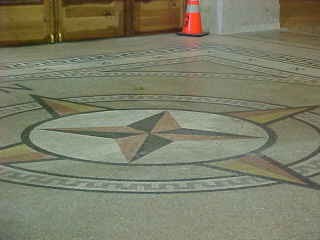
The fantastic compass rose on the entrance floor.
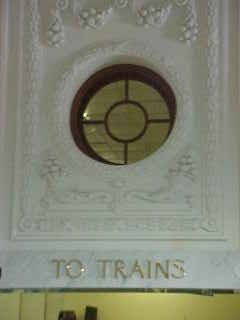
Above, To Trains.
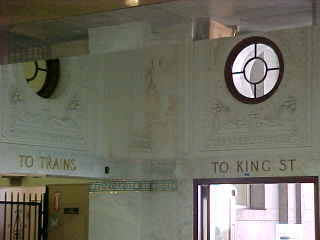
Above the exit to the street.
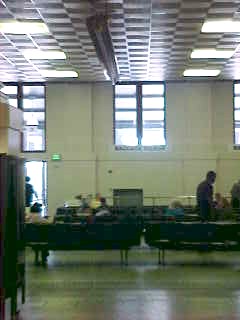
The present old "bus depot drop ceiling", which was to be removed.
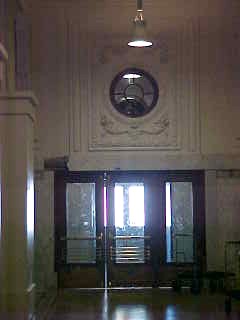
One of the doors out to the platforms.

A lighting fixture.
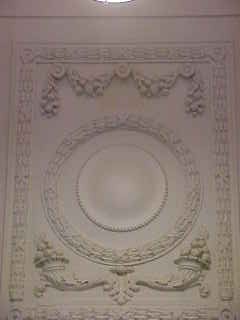
An restored upper wall.
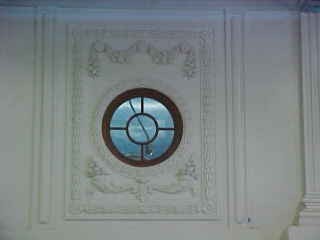
One of the restored upper windows.
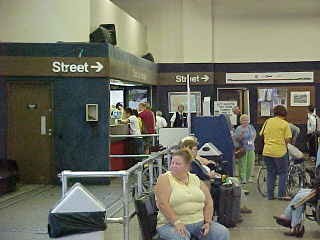
The present ticket counter and seating area.
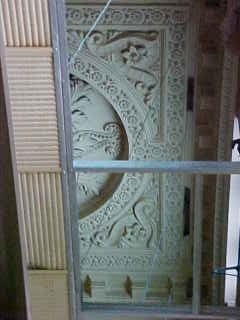
Looking up between the old "bus depot drop ceiling", you can see the true beautiful station ceiling.
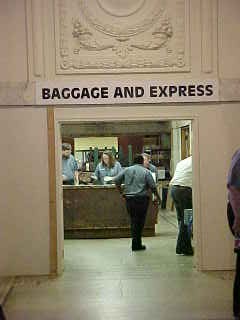
The door to the baggage room. I would now wait for the Relaunching of the Empire Builder but first went walked down to the Amtrak yards.
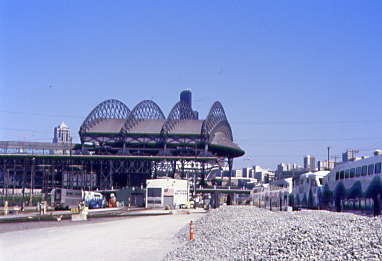
The view into the yard with Safeco Field in the background.
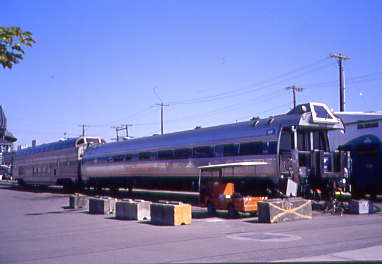
Amtrak observation-sleeping car Beech Grove 10001, nee Amfleet 84-seat coach 21222 built by Budd Company in 1976.
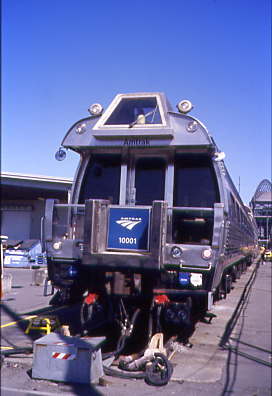
The open platform of "Beech Grove". I walked back to Pioneer Square but found something more interesting.
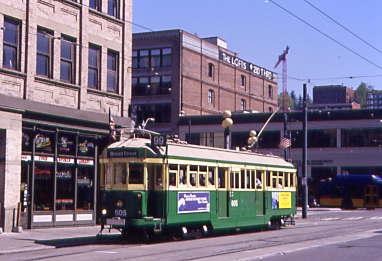
Waterfront streetcar 605 came from the east and went into the passing track.
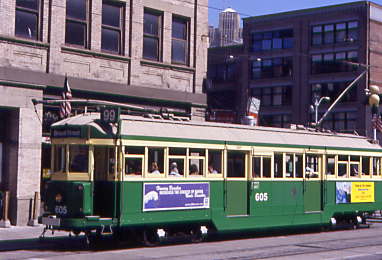
Car 605 now waited for Car 272 to arrive from Broad Street.
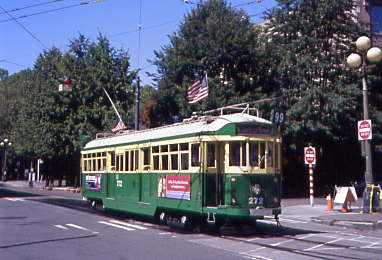
Car 272 could now proceed to the end of the line at Jackson Street and the Financial District. I now returned back to King Street Station.
| RETURN TO THE MAIN PAGE |